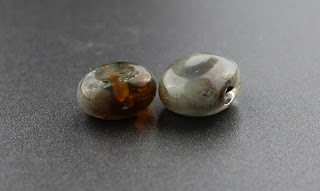I am intrigued by this new, beautiful orange-yellow opal colour from Creation is Messy called Scotch Broom (CiM327). It's like nothing else I've ever tried, and everything I made with it so far is pretty ugly because I just don't have it figured out yet. The only thing a girl can do in this situation is buy a full pound of it and really buckle down to figure it out, so I just messaged Nortel to ask them to add a pound of Scotch Broom to my order.
OK, so why, if everything I've made with it so far is icky, have I just ordered a pound of Scotch Broom? Because I love the colour so much in the rod and in the plain spacers I made that I really need to figure it out. It's completely unique and crazy beautiful.
This is Scotch Broom in spacers. It seems like it is slow to strike back to opalescence, so these beads just look transparent. What a gorgeous, warm colour!
These little beads are Scotch Broom with silver leaf. The bead on the right is encased with Effetre 006 Clear.
The only surviving things I have made with this colour are truly ugly, and out of those, this is the least embarrassing one that made it past the water jar, so this is the one I'll put here:
This bead has Kniphofia in the core, encased with Scotch Broom. I made an incorrect assumption when I started using this colour that it would end up more opaque like the rod, and that was not the case. I got more opacification of it in this bead than in the little spacers, so it seems like working it longer can help with that if opacity is what you're after.
No one will ever know what possessed me to put blue and aqua flowers on top of this colour, and I did not expect the flower petal colours to let so much orange through. The flower effectively looks brown.
I will repost about this colour when I've been able to give it a better workout. My results here definitely don't seem reflective of its potential.






























